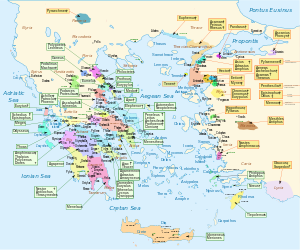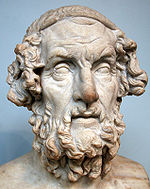- Mycenaean Greek
-
This article is about Achaean Greek. For the later dialect used in Achaea and the Peloponnese, see Achaean Doric Greek.
Mycenaean Greek Spoken in southern Balkans/Crete Extinct 12th century BC Language family Indo-European- Hellenic
- Ancient Greek
- Mycenaean Greek
- Ancient Greek
Writing system Linear B Language codes ISO 639-3 gmy  Map of Greece as described in Homer's Iliad. The geographical data is believed to refer primarily to Bronze Age Greece, when Mycenaean Greek would have been spoken, and therefore can be used as an estimator of the range.
Map of Greece as described in Homer's Iliad. The geographical data is believed to refer primarily to Bronze Age Greece, when Mycenaean Greek would have been spoken, and therefore can be used as an estimator of the range.This page contains IPA phonetic symbols in Unicode. Without proper rendering support, you may see question marks, boxes, or other symbols instead of Unicode characters. History of the
Greek language
(see also: Greek alphabet)
Proto-Greek (c. 3000–1600 BC) Mycenaean (c. 1600–1100 BC) Ancient Greek (c. 800–330 BC)
Dialects:
Aeolic, Arcadocypriot, Attic-Ionic,
Doric, Locrian, Pamphylian,
Homeric Greek,
Macedonian (?)Koine Greek (c. 330 BC–330) Medieval Greek (330–1453) Modern Greek (from 1453)
Dialects:
Calabrian, Cappadocian, Cheimarriotika, Cretan,
Cypriot, Demotic, Griko, Katharevousa,
Pontic, Tsakonian, Maniot, Yevanic
*Dates (beginning with Ancient Greek) from Wallace, D. B. (1996). Greek Grammar Beyond the Basics: An Exegetical Syntax of the New Testament. Grand Rapids: Zondervan. p. 12. ISBN 0310218950.Mycenaean Greek is the most ancient attested form of the Greek language, spoken on the Greek mainland, Crete and Cyprus in the 16th to 12th centuries BC, before the hypothesised Dorian invasion which was often cited as the terminus post quem for the coming of the Greek language to Greece. The language is preserved in inscriptions in Linear B, a script first attested on Crete before the 14th century BC. Most instances of these inscriptions are on clay tablets found in Knossos in central Crete, and in Pylos in the southwest of the Peloponnese. Other tablets have been found at Mycenae itself, Tiryns and Thebes and at Chania in Western Crete.[1] The language is named after Mycenae, one of the major centres of Mycenaean Greece.
The tablets remained long undeciphered, and every conceivable language was suggested for them, until Michael Ventris deciphered the script in 1952 and by a preponderance of evidence proved the language to be an early form of Greek.
The texts on the tablets are mostly lists and inventories. No prose narrative survives, much less myth or poetry. Still, much may be glimpsed from these records about the people who produced them and about Mycenaean Greece, the period before the so-called Greek Dark Ages.
Contents
Orthography
The Mycenaean language is preserved in Linear B writing, which consists of about 200 syllabic signs and logograms. Since Linear B was derived from Linear A, the script of an undeciphered Minoan language probably unrelated to Greek, it does not reflect fully the phonetics of Mycenaean. In essence, a limited number of syllabic signs must represent a much greater number of produced syllables, better represented phonetically by the letters of an alphabet. Orthographic simplifications therefore had to be made. The main ones are:[2]
- There is no disambiguation for the Greek phonological categories of voice and aspiration, excepting dentals d, t: e-ko may be either egō or ekhō.
- Any m and n before a consonant and any incidence of syllable-final l, m, n, r, s are omitted. Pa-ta is panta; ka-ko is khalkos.
- Consonant clusters must be dissolved orthographically, creating apparent vowels: po-to-li-ne is ptolin.
- R and L are not disambiguated: pa-si-re-u is basileus.
- Initial aspiration is not indicated: a-ni-ja is hāniai.
- Length of vowels is not marked.
- The consonant usually transcribed 'z' probably represents *dy, initial *y, *ky, *gy.[3]
- q- is a labio-velar kʷ or gʷ and in some names ghʷ:[3] qo-u-ko-ro is gʷoukoloi, classical boukoloi.
- Initial s before a consonant is not written: ta-to-mo is stathmos.
- Double consonants are not represented: ko-no-so is Knōsos, classical Knossos.
In addition to these spelling rules, signs are not polyphonic (more than one sound) but sometimes they are homophonic (a sound can be represented by more than one sign), which are not "true homophones" but are "overlapping values."[4] Long words may omit a middle or final sign.
For more details on this topic, see Linear B.Phonology
The script differentiates five vowel qualities, a, e, i, o, u, the semivowels w and j (also transcribed as y), three sonorants, m, n, r (standing in for l as well), one sibilant s and six occlusives, p, t, d, k, q (the usual transcription for all labiovelars) and z (which includes [kʲ], [ɡʲ] and [dʲ] sounds which later became Greek ζ).
Mycenaean also preserves /w/, which survived in some Greek dialects as the alphabetic digamma or F until it was altogether lost later, and the intervocalic /h/.
The Mycenaean form of Greek preserves a number of archaic features of its Indo-European heritage, such as the labiovelar consonants that underwent context-dependent sound changes by the time alphabetic Greek writing began a few hundred years later.
Morphology
Unlike later varieties of Greek, Mycenaean Greek probably had seven grammatical cases, the nominative, the genitive, the accusative, the dative, the instrumental, the locative, and the vocative. The instrumental and the locative had fallen out of use by Classical Greek, and in modern Greek, only the nominative, accusative, genitive and vocative remain.[5]
Greek features
Main article: Proto-Greek languageMycenaean has already undergone the following sound changes peculiar to the Greek language and therefore is considered to be Greek.[6]
Phonological changes
- Initial and intervocalic *s have been lost
- Voiced aspirates have been devoiced
- Syllabic liquids have become ar/al or or/ol; syllabic nasals have become a or o.
- *kj and *tj have become s before a vowel
- Initial *j has been lost or replaced by ζ (exact value unknown, possibly [dz])
- *gj and *dj have become ζ
Morphological changes
- The use of -eus to produce agent nouns
- The third person singular ending -ei
- The infinitive ending -ein (contracted from -e-en)
Lexical items
- Uniquely Greek words; e.g., *wanaks (= ἄναξ ánax 'lord'), *gʷasileus (= βασιλεύς basiléus 'king'), *elaiwon (= ἔλαιον élaion 'olive').
- Greek forms of words known in other languages; e.g., theos, tripos, khalkos.
Corpus
Main article: Linear B#CorpusThe corpus of Mycenaean-era Greek writing consists of some 6,000 tablets and potsherds in Linear B, from LMII to LHIIIB. No Linear B monuments nor non-Linear B transliterations have yet been found.
If it is genuine, the Kafkania pebble, dated to the 17th century BC, would be the oldest known Mycenean inscription, and hence the earliest preserved testimony of the Greek language.
See also
Notes
- ^ *Chadwick, John (1976). The Mycenaean World. Cambridge UP. ISBN 0521290376.
- ^ Ventris and Chadwick (1973) pages 42–48.
- ^ a b Ventris and Chadwick (1973) page 389.
- ^ Ventris & Chadwick (1973) page 390.
- ^ Andrew Garrett, "Convergence in the formation of Indo-European subgroups: Phylogeny and chronology", in Phylogenetic methods and the prehistory of languages, ed. Peter Forster and Colin Renfrew (Cambridge: McDonald Institute for Archaeological Research), 2006, p. 140, citing Ivo Hajnal, Studien zum mykenischen Kasussystem. Berlin, 1995, with the proviso that "the Mycenaean case system is still controversial in part".
- ^ Ventris & Chadwick (1973) page 68.
References
- Chadwick, John (1958). The Decipherment of Linear B. Second edition (1990). Cambridge UP. ISBN 0521398304.
- Chadwick, John (1976). The Mycenaean World. Cambridge UP. ISBN 0521290376.
- Ventris, Michael; Chadwick, John (1953). "Evidence for Greek dialect in the Mycenaean archives". Journal of Hellenic Studies 73: 84–103. doi:10.2307/628239. JSTOR 628239.
- Ventris, Michael and Chadwick, John (1956). Documents in Mycenaean Greek. Second edition (1973). Cambridge UP. ISBN 0521085586.
- Bartoněk, Antonin (2003). Handbuch des mykenischen Griechisch. Universitätsverlag C. Winter. ISBN 3825314359.
Further reading
- Easterling, P & Handley, C. Greek Scripts: An illustrated introduction. London: Society for the Promotion of Hellenic Studies, 2001. ISBN 0902984179
External links
- Jeremy B. Rutter, "Bibliography: The Linear B Tablets and Mycenaean Social, Political, and Economic Organization"
- The writing of the Mycenaeans (contains an image of the Kafkania pebble)
- Program in Aegean Scripts and Prehistory (PASP)
- Markos Gavalas, MYCENAEAN (Linear B) – ENGLISH Dictionary (explorecrete.com)
- Palaeolexicon, Word study tool of ancient languages
Ancient Greece Periods Geography Politics Rulers - Kings of Sparta
- Kings of Athens
- Archons of Athens
- Kings of Macedon
- Kings of Pontus
- Kings of Paionia
- Roman Emperors
- Kings of Kommagene
- Kings of Lydia
- Attalid Kings of Pergamon
- Diadochi
- Kings of Argos
- Tyrants of Syracuse
Life - Agriculture
- Clothing
- Cuisine
- Democracy
- Economy
- Education
- Festivals
- Homosexuality
- Law
- Marriage
- Mourning ritual
- Olympic Games
- Pederasty
- Philosophy
- Prostitution
- Religion
- Slavery
- Warfare
- Wine
Military - Wars
- Army of Macedon
- Antigonid Macedonian army
- Pezhetairoi
- Hoplite
- Seleucid army
- Hellenistic armies
- Phalanx formation
- Peltast
- Sarissa
- Xyston
- Sacred Band of Thebes
People OthersGroups- Playwrights
- Poets
- Philosophers
- Tyrants
- Mythological figures
CulturesBuildings Arts Sciences Language Writing Lists - Cities in Epirus
- Theatres
- Cities
- Place names
Greek language · Eλληνική γλώσσα History Proto-Greek (c. 3000–1600 BC) · Mycenaean (c. 1600–1000 BC) · Ancient Greek (c. 1000–330 BC) · Koine Greek (c. 330 BC–330) · Medieval Greek (330–1453) · Modern Greek (from 1453)
Alphabet Letters Phonology Grammar Dialects Cappadocian · Cretan · Cypriot · Chalkidiki · Demotic · Greek-Calabrian · Griko · Katharevousa · Macedonian · Misthiotica · Pontic · Tsakonian · YevanicLiterature Related Topics Promotion and Study Ages of Greek c. 3rd millenium BC c. 1600–1100 BC c. 800–300 BC c. 300 BC – AD 330 c. 330–1453 since 1453 Mycenaean
Categories:- Mycenaean Greek language
- Varieties of Ancient Greek
- Ancient languages
- Languages of ancient Thessaly
- Languages of ancient Crete
- Hellenic
Wikimedia Foundation. 2010.
